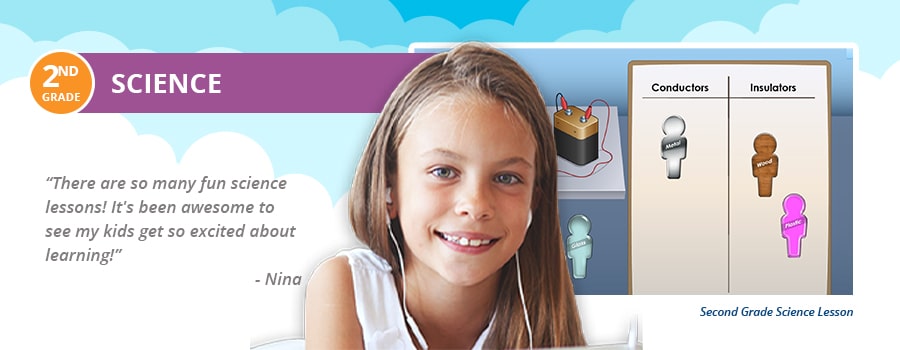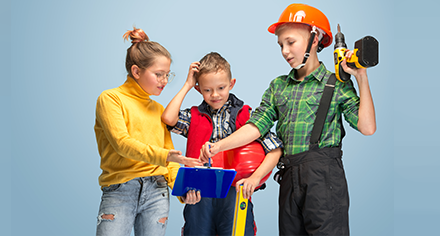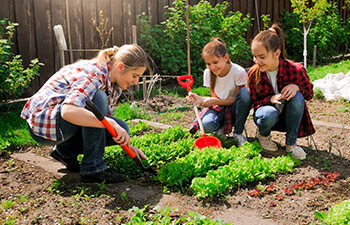Second Grade Homeschool Science Curriculum
We live in a world that values discovery and invention, with expanding career opportunities in science, technology, engineering and math (STEM). Because we can expect that trend to continue, the science instruction your child receives is more important than ever. When you are researching the best 2nd grade science curriculum, you want to find one that covers essential knowledge, uses hands-on activities to stimulate inquiry, and makes your child curious about the world around them.
What Do You Teach in Science in 2nd Grade?
In second grade, students learn to plan and conduct experiments. From states of matter and how they transform, to creating Earth models using different materials and more. Observation and note taking will continue to be key during second grade as they learn more advanced concepts that will be essential for them in the future.
Because each state has different science standards, the topics covered in second grade science will vary from state to state and even school to school. When homeschooling, you have the freedom to focus on the concepts that you choose, but some of the most common topics covered in 2nd grade science curriculum are:
- Life science (plants and animals and their habits and life cycles)
- Earth/Space science (properties of suns, moons, planets, and stars)
- Physical science (states of matter, electricity, and magnetism)
Our second grade science lessons build on the skills gained in earlier grades and challenge them with progressively more complex material. While facts are important, an effective science curriculum will encourage students to observe, ask questions, and explore concepts for themselves.
Second Grade Science Objectives
Second graders will acquire a broad range of skills for understanding the natural world around them. This year, they will start making detailed observations, drawing conclusions from data, and even learn how to make use of the information they gather.
Some of the specific goals for second grade science include:
- Demonstrating scientific reasoning and logic
- Learning to measure in both English and metric units
- Applying scientific concepts, skills, and processes to everyday experiences
- Describing/summarizing scientific processes both orally and in writing
Make sure that your child’s second grade science curriculum meets or exceeds these goals. A well-planned program will provide opportunities for inquiry, experimentation and implementation.
Time4Learning’s Second Grade Science Scope & Sequence
Matter can change in many ways; some changes alter the appearance, while others create new and different matter. In this module, students explore chemical changes and physical changes, including phase changes, of matter.
Electrical energy is energy that is used to run appliances and tools. Electricity is generated at power plants from renewable and nonrenewable energy sources before it travels through power lines to all of the necessary locations. In this module students explore the various uses of electricity and the energy sources used to generate electricity.
Heat energy is energy that can be felt. Heat energy can be natural, like the heat we get from the sun, or manmade. In this module students explore the properties and characteristics of heat energy, its uses, and various sources of manmade and natural heat.
Energy is everywhere, and it is used to accomplish many different things, while transforming from sunlight to food and from electricity to heat, light and sound. This module guides students through an exploration of energy transformations in living and nonliving systems.
Fast or slow, objects, people, animals, liquids, and even gases move. In this module students begin to describe and learn to measure motion, a change in position.
Work is made easy with simple machines; they reduce the force needed to move an object over a distance. This module introduces the six types of simple machines — lever, pulley, wheel and axle, wedge, screw, and inclined plane — as students explore what a simple machine is and how simple machines work.
Opening a door, closing a lid, or skipping to school – each action requires the right push or pull. This module guides students as they explore force, a push or a pull. It includes gravity and how much of a push or a pull is needed to move various objects over a distance.
The Earth has changed since its beginning and continues to change today. Most of the changes on Earth happen over such a long period of time they cannot be observed. In this module students experience how the Earth has changed over time and learn about the clues that are used to identify those changes.
Mountains, canyons, lakes, and rivers are some of Earth’s features. Although they give shape to the surface of the Earth, over time the movement of wind and water causes these features to change. In this module, students discover how weathering and erosion change Earth’s features over time.
Over and over, the Moon changes phase, day turns to night and spring becomes summer. These cycles of change happen as the Earth spins on its axis while orbiting around the sun. This module introduces students to the different cycles observed on Earth.
The Universe contains everything, from stars and planets to solar systems and galaxies — even you. In this module, students will explore the different objects that make up the Universe and the tools we need to observe space.
All of the living things that make up the environment depend on each other to meet their needs–even people! When changes happen in the environment, living things respond. In this module, students see how changes in an environment can affect the natural world as they learn the importance of being eco aware.
Plants and animals live in many different habitats such as the forest, desert, ocean, pond, or farm. Although these habitats may look very different, they all meet the needs of the plants and animals that live there. This module introduces students to different types of habitats and the living things that are found in them.
All living things need energy to live and grow. Most plants get their energy from sunlight whereas people and other animals get their energy from the food they eat. This module explores the relationships between living things and the energy sources they need to thrive.
Why Choose Time4Learning’s Second Grade Science Homeschool Curriculum
Time4Learning’s science curriculum makes it fun and easy for families to teach science at home. To keep kids interested and motivated to learn, the program uses a combination of animated lessons, engaging online and offline activities, worksheets, quizzes and tests.
Families can use Time4Learning’s second grade science curriculum as their core homeschool program or as a supplement for skill building.







